From the Trenches
Mirror, Mirror
By DANIEL WEISS
Friday, June 08, 2018
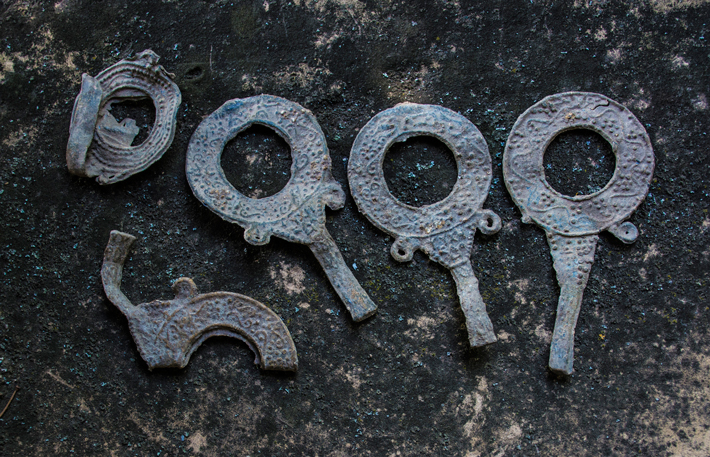 Five lead mirror frames dating to the turn of the third century A.D. have been found in a square building at a Roman villa outside the town of Pavlikeni in northern Bulgaria. Three of the frames are decorated with the image of a large wine vessel and bear an inscription that means a “good soul.” The villa belonged to a Roman military veteran and was built around the turn of the second century A.D. The building where the frames were found was thought to have housed villa workers. But, says excavation leader Karin Chakarov of the Pavlikeni Museum of History, the presence of the mirror frames suggests it may instead have been a temple.
Five lead mirror frames dating to the turn of the third century A.D. have been found in a square building at a Roman villa outside the town of Pavlikeni in northern Bulgaria. Three of the frames are decorated with the image of a large wine vessel and bear an inscription that means a “good soul.” The villa belonged to a Roman military veteran and was built around the turn of the second century A.D. The building where the frames were found was thought to have housed villa workers. But, says excavation leader Karin Chakarov of the Pavlikeni Museum of History, the presence of the mirror frames suggests it may instead have been a temple.
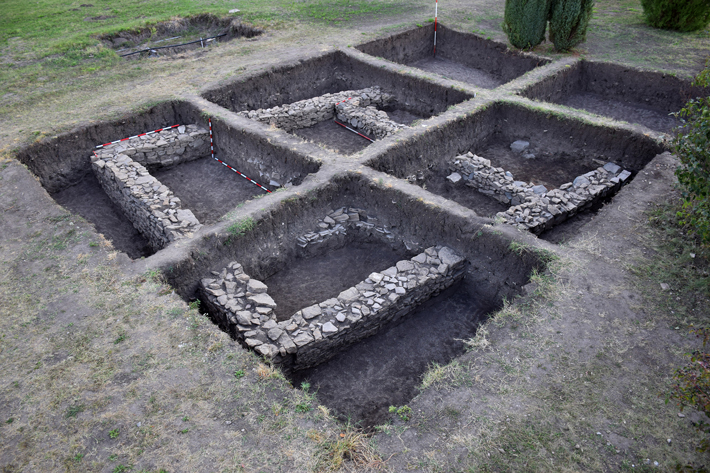
Honoring Osiris
By MARLEY BROWN
Friday, June 08, 2018
 Archaeologists working near the temple complex of Karnak in Luxor, Egypt, are making sense of an out-of-the-way chapel devoted to the god Osiris. The remains of the Chapel of Osiris-Ptah Neb-ankh lie south of Karnak’s Tenth Pylon and east of the famed avenue of ram-headed sphinxes. The structure is believed to have been built by the 25th Dynasty Kushite pharaohs Taharqa and Tantamani—who are represented on reliefs within the chapel—in the seventh century B.C., and was originally discovered by locals in the nineteenth century. Researchers have now mapped the building’s entrance and foundations, and have uncovered a collection of clay pots and statue fragments. “Every king wanted the honor of making a mark on the great religious complex of Karnak,” explains project director Essam Nagy of the Egypt Exploration Society. “The cult of Osiris had grown in importance, so the Kushite-period rulers built shrines and chapels at the site to reflect that.”
Archaeologists working near the temple complex of Karnak in Luxor, Egypt, are making sense of an out-of-the-way chapel devoted to the god Osiris. The remains of the Chapel of Osiris-Ptah Neb-ankh lie south of Karnak’s Tenth Pylon and east of the famed avenue of ram-headed sphinxes. The structure is believed to have been built by the 25th Dynasty Kushite pharaohs Taharqa and Tantamani—who are represented on reliefs within the chapel—in the seventh century B.C., and was originally discovered by locals in the nineteenth century. Researchers have now mapped the building’s entrance and foundations, and have uncovered a collection of clay pots and statue fragments. “Every king wanted the honor of making a mark on the great religious complex of Karnak,” explains project director Essam Nagy of the Egypt Exploration Society. “The cult of Osiris had grown in importance, so the Kushite-period rulers built shrines and chapels at the site to reflect that.”
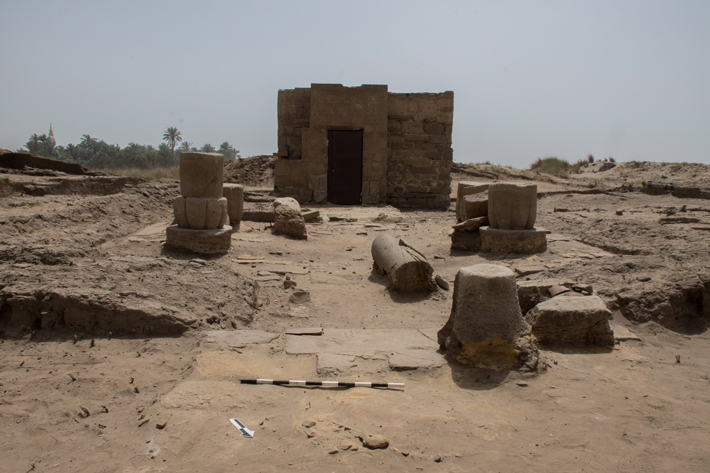
Sun Storm
By ROGER ATWOOD
Friday, June 08, 2018
A massive disk of intricately carved stone looms over a gallery in Mexico City’s National Museum of Anthropology. The stone has long been an emblem of Mexican identity. Commissioned by the Aztec ruler Moctezuma II (r. 1502–1520), the nearly 12-foot-wide stone was completed during his reign, in about 1511. Eight years later, when Spanish conquistadores saw it atop a platform in the Aztecs’ central temple, the Templo Mayor, in the capital city of Tenochtitlan, one described it as “round, like a figure of the sun.” When the Spaniards leveled the capital, the stone disappeared, only to be rediscovered in 1790 beneath the city’s main plaza, the Zócalo, a block from where the conquistadores had seen it.
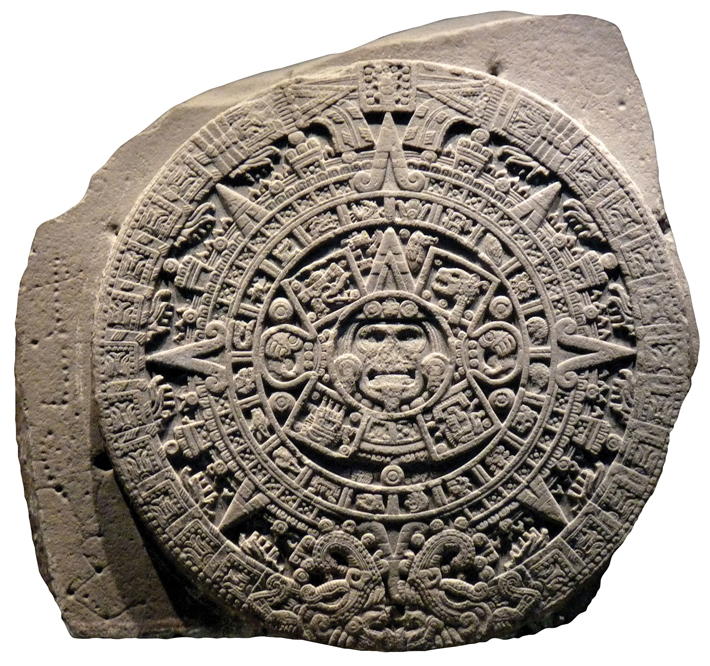 The meaning of this 22-ton disk of volcanic basalt has been subject to a variety of interpretations. The first article written about it in 1792 suggested that it functioned as a clock or sundial. Most researchers have concluded that the figure at the stone’s center represents an Aztec deity, possibly the sun god Tonatiuh—and most still do. But now archaeologist David Stuart of the University of Texas at Austin has a provocative new theory about the central figure. He presented it in the magazine Arqueología Mexicana, and his reading of the famous artifact has set off debate among scholars of ancient Mexico in the magazine’s pages and beyond.
The meaning of this 22-ton disk of volcanic basalt has been subject to a variety of interpretations. The first article written about it in 1792 suggested that it functioned as a clock or sundial. Most researchers have concluded that the figure at the stone’s center represents an Aztec deity, possibly the sun god Tonatiuh—and most still do. But now archaeologist David Stuart of the University of Texas at Austin has a provocative new theory about the central figure. He presented it in the magazine Arqueología Mexicana, and his reading of the famous artifact has set off debate among scholars of ancient Mexico in the magazine’s pages and beyond.
Citing iconic messages on the stone and comparisons to other monuments, Stuart suggests the figure is Moctezuma II himself, represented as the sun god. “People would have seen it as a depiction of the ruler, with the face of the king and the face of the sun being one and the same. The overlap between kings and gods was very important to the Aztecs,” says Stuart. He notes that a glyph above the face reads “One Flint,” the name for the year in which the god Huitzilopochtli was believed to have migrated from his mythic homeland to the central valley of Mexico at the dawn of the Aztec state. Another glyph, slightly to the left, represents a xiuhhuitzolli, a diadem or headdress, worn by the Aztec ruler himself. Stuart believes the two glyphs, taken together, send a clear message of royal power and identity. “It’s a portrait of the deified king. Aztec commoners would have read ‘This is the king. The king is a god.’ Seeing the central figure as a portrait makes it a very historical and political monument.”
Other Mesoamerican experts, however, disagree. Archaeologist Eduardo Matos Moctezuma, former director of the Templo Mayor excavations, has argued that Stuart’s interpretation is groundless. He writes in Arqueología Mexicana that Stuart has misread the glyph that he believes represents the royal headdress, which, he says, is, instead, part of a longer glyph with no direct relation to the ruler. Moreover, the man in the center of the stone has a tongue-like sacrificial knife hanging out of his mouth. According to Matos, no other portrait of an Aztec ruler has such an attribute.
Patrick Hajovsky, a Southwestern University archaeologist, also disputes Stuart’s theory, saying that although the glyph to the left of the figure might indeed be that of Moctezuma, that would not mean the figure depicted is the king. “By that logic, then, the central figure could just as well be Huitzilopochtli, the god whose name appears in the innermost circle,” he says. He observes that in other works featuring Moctezuma, he never appears in the center of the sun, “but rather to its side, making offerings.”
Stuart admits that by arguing that the stone depicts an actual person—not a god—he is, in a way, demystifying it. “They would have seen it as a person, and I guess that brings it down to earth,” he says. Yet the face is more than just a portrait of Moctezuma. “It plays off multiple identities that revolved around kings and deities,” he says. “The face is several things at once.”
Off the Grid
By MARLEY BROWN
Friday, June 08, 2018
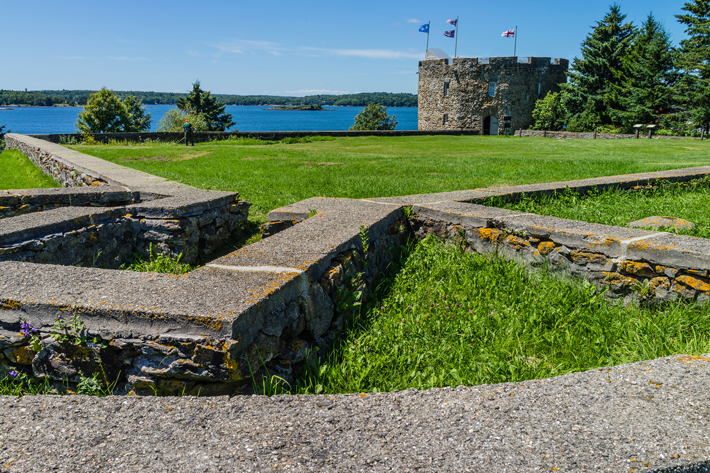 The remains of an early and tenacious English outpost in North America can be found on the Pemaquid Peninsula of Maine’s south-central coast. Colonial Pemaquid began as a seasonal fishing community on the islands of Monhegan and Damariscove in the first decade of the seventeenth century. Settlers representing wealthy Bristol merchants built a village on the site by the late 1620s and began trading with French colonists to the north and members of the Wabanaki Confederacy, whose ancestors had lived in the area for millennia. Wabanaki war parties destroyed Pemaquid’s main village in 1676 and again in 1698, along with two forts built successively to protect the settlement.
The remains of an early and tenacious English outpost in North America can be found on the Pemaquid Peninsula of Maine’s south-central coast. Colonial Pemaquid began as a seasonal fishing community on the islands of Monhegan and Damariscove in the first decade of the seventeenth century. Settlers representing wealthy Bristol merchants built a village on the site by the late 1620s and began trading with French colonists to the north and members of the Wabanaki Confederacy, whose ancestors had lived in the area for millennia. Wabanaki war parties destroyed Pemaquid’s main village in 1676 and again in 1698, along with two forts built successively to protect the settlement.
The village ruins lie at the center of a site where archaeologists have been working since the 1960s. Finds uncovered, including a German bellarmine stoneware jug, a Venetian trade bead, Caribbean coral fragments, and a Yoruba divination tapper made of elephant ivory, suggest that Pemaquid was not merely a site of conflict, but also a nexus for goods and people from around the maritime world. “It was a small settlement on the fringes of New England that was isolated in one sense,” explains Neill De Paoli, Colonial Pemaquid park manager, “but at the same time it was part of a large international network that extended well beyond the coast of Maine to the Caribbean, West Africa, and Europe.”
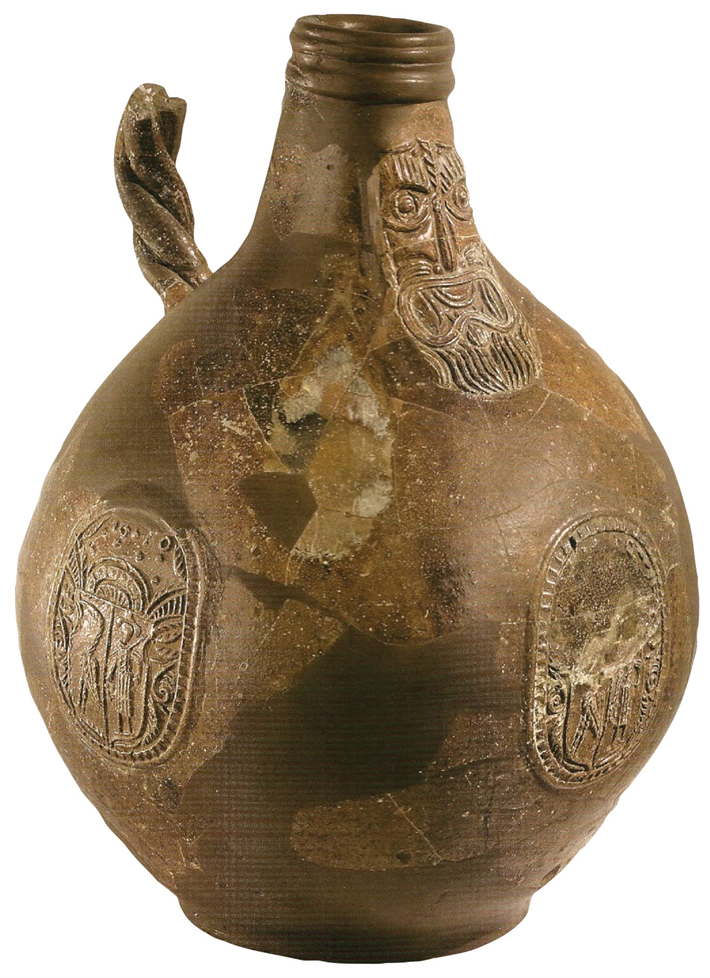 THE SITE
THE SITE
Visitors will first encounter a partial reconstruction of the 1692 Fort William Henry, which houses exhibits on the lives of soldiers posted at Pemaquid and parleys held among the Wabanaki, the French, and the English. Continue on to the museum to watch a video overview of Pemaquid’s history and the archaeological research conducted at the site. The museum displays many prehistoric and colonial artifacts discovered in the area, as well as a wealth of information about the region’s Native American heritage, the seventeenth-century fishing industry, and the business of tavern-keeping. Daily tours include a visit to a reconstructed wattle-and-daub cottage, where, on weekends, interpreters ply trades such as blacksmithing and carpentry.
WHILE YOU’RE THERE
Drive just south to the Pemaquid Point Lighthouse, commissioned by President John Quincy Adams in 1827, to learn about the local economy at the Fishermen’s Museum, or head back inland to the town of Damariscotta to see the Whaleback Shell Midden, evidence of thousands of years of indigenous communities sustained by the sea. Hungry travelers in search of their own seafood lunch should head to nearby New Harbor for a lobster roll and spectacular views that were shared by sailors returning from Monhegan in the 1620s.
Advertisement
Advertisement
IN THIS ISSUE
Features
Westminster Abbey’s Hidden History
The City at the Beginning of the World
Letter from England
From the Trenches
Sun Storm
Off the Grid
Honoring Osiris
Mirror, Mirror
Pompeii Revisited
Nazi Sub Discovered
Divine Invitation
Samurai Nest Egg
Far From Home
Late Antique TLC
Pinpoint Precision
A Final Account
Seaworthy Sumerians
Tales Out of School
World Roundup
New Mexico’s giant sloth, Peruvian llama sacrifice, Sweden’s oldest onion, bovine brain surgery, and the first Arabians
Artifact
It was a bout time, too
Advertisement

Recent Issues
-
 May/June 2024
May/June 2024
-
 March/April 2024
March/April 2024
-
 January/February 2024
January/February 2024
-
 November/December 2023
November/December 2023
-
 September/October 2023
September/October 2023
-
 July/August 2023
July/August 2023
-
 May/June 2023
May/June 2023
-
 March/April 2023
March/April 2023
-
 January/February 2023
January/February 2023
-
 November/December 2022
November/December 2022
-
 September/October 2022
September/October 2022
-
 July/August 2022
July/August 2022
-
 May/June 2022
May/June 2022
-
 March/April 2022
March/April 2022
-
 January/February 2022
January/February 2022
-
 November/December 2021
November/December 2021
-
 September/October 2021
September/October 2021
-
 July/August 2021
July/August 2021
-
 May/June 2021
May/June 2021
-
 March/April 2021
March/April 2021
-
 January/February 2021
January/February 2021
-
 November/December 2020
November/December 2020
-
 September/October 2020
September/October 2020
-
 July/August 2020
July/August 2020
-
 May/June 2020
May/June 2020
-
 March/April 2020
March/April 2020
-
 January/February 2020
January/February 2020
-
 November/December 2019
November/December 2019
-
 September/October 2019
September/October 2019
-
 July/August 2019
July/August 2019
-
 May/June 2019
May/June 2019
-
 March/April 2019
March/April 2019
-
 January/February 2019
January/February 2019
-
 November/December 2018
November/December 2018
-
 September/October 2018
September/October 2018
-
 July/August 2018
July/August 2018
-
 May/June 2018
May/June 2018
-
 March/April 2018
March/April 2018
-
 January/February 2018
January/February 2018
-
 November/December 2017
November/December 2017
-
 September/October 2017
September/October 2017
-
 July/August 2017
July/August 2017
-
 May/June 2017
May/June 2017
-
 March/April 2017
March/April 2017
-
 January/February 2017
January/February 2017
-
 November/December 2016
November/December 2016
-
 September/October 2016
September/October 2016
-
 July/August 2016
July/August 2016
-
 May/June 2016
May/June 2016
-
 March/April 2016
March/April 2016
-
 January/February 2016
January/February 2016
-
 November/December 2015
November/December 2015
-
 September/October 2015
September/October 2015
-
 July/August 2015
July/August 2015
-
 May/June 2015
May/June 2015
-
 March/April 2015
March/April 2015
-
 January/February 2015
January/February 2015
-
 November/December 2014
November/December 2014
-
 September/October 2014
September/October 2014
-
 July/August 2014
July/August 2014
-
 May/June 2014
May/June 2014
-
 March/April 2014
March/April 2014
-
 January/February 2014
January/February 2014
-
 November/December 2013
November/December 2013
-
 September/October 2013
September/October 2013
-
 July/August 2013
July/August 2013
-
 May/June 2013
May/June 2013
-
 March/April 2013
March/April 2013
-
 January/February 2013
January/February 2013
-
 November/December 2012
November/December 2012
-
 September/October 2012
September/October 2012
-
 July/August 2012
July/August 2012
-
 May/June 2012
May/June 2012
-
 March/April 2012
March/April 2012
-
 January/February 2012
January/February 2012
-
 November/December 2011
November/December 2011
-
 September/October 2011
September/October 2011
-
 July/August 2011
July/August 2011
-
 May/June 2011
May/June 2011
-
 March/April 2011
March/April 2011
-
 January/February 2011
January/February 2011
Advertisement






